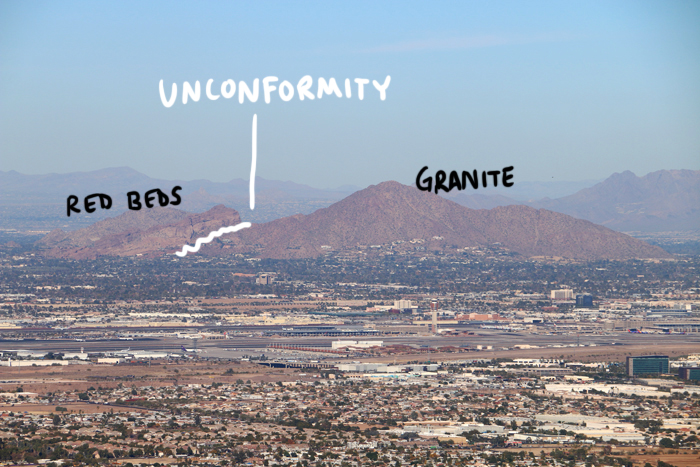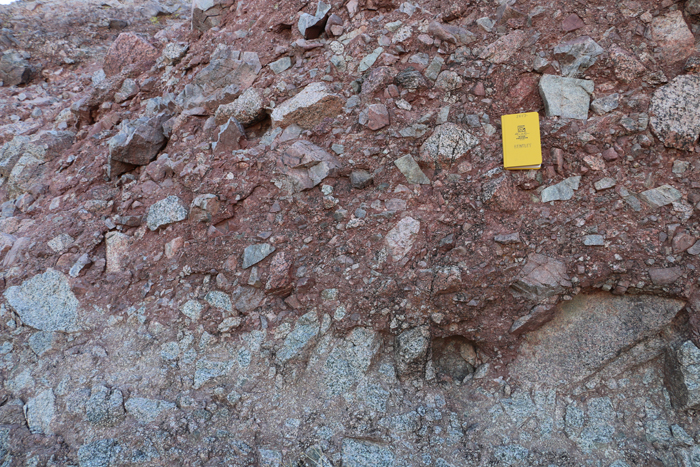11 January 2018
Landslide breccias in Papago Park
Posted by Callan Bentley

Yesterday I outlined the idea of metamorphic core complexes, as expressed in the South Mountains, south of Phoenix, Arizona. We examined the ductilely-deformed footwall rocks. But a bunch of rock slid off the top, too, breaking into domino-like chunks as it slid along the detachment fault. The local mountain called Camelback is mostly made of granite that originally derived from the South Mountains, but it’s on the other side of Phoenix now. It also features a distinctive unconformity, separating the granite from overlying oxidized Neogene landslide deposits – the “red beds” in the image below:

Today we will journey to Papago Park. It has many more examples of these red beds, which in spite of tilted bedding show horizontally-oriented holes of “mega-tafoni.”

One of these is known locally as “Hole in the Rock.” Here it is, with some people for scale:

Hole in the Rock is basically a small version of Camelback:


The granite here is the tip of a big block of hanging wall rock from the South Mountain detachment. It’s mostly submerged in a sea of modern sediment, but also bears a load of lithified breccia. This is the Neogene-aged Camel’s Head Formation. It’s pretty angular, and pretty poorly sorted:


The clasts comprising this sedimentary breccia imply a nearby source of lots of granite, and also some finely-banded rhyolite:

Therefore, there must have been a mountain nearby in the past to shed these clasts off – some local relief from which landslides and debris flows might issue. The mountain is now absent, either eroded to nothing or else buried under the Phoenix Basin’s sedimentary valley fill.
Zooming in on one of the boulders, you can see (in the lower right) a primary igneous contact between the granite and the rhyolite:


So we can actually say something about the structure of this long-departed mountain range by examining a pile of sedimentary clasts like these. Neat-o!
I should also point out that this red bed breccia weathers out beautifully as a series of small buttes looking south toward Tempe and southwest toward Phoenix:

It’s a neat place to visit, clamber around, and contemplate the annals of the former world.


 Callan Bentley is Associate Professor of Geology at Piedmont Virginia Community College in Charlottesville, Virginia. He is a Fellow of the Geological Society of America. For his work on this blog, the National Association of Geoscience Teachers recognized him with the James Shea Award. He has also won the Outstanding Faculty Award from the State Council on Higher Education in Virginia, and the Biggs Award for Excellence in Geoscience Teaching from the Geoscience Education Division of the Geological Society of America. In previous years, Callan served as a contributing editor at EARTH magazine, President of the Geological Society of Washington and President the Geo2YC division of NAGT.
Callan Bentley is Associate Professor of Geology at Piedmont Virginia Community College in Charlottesville, Virginia. He is a Fellow of the Geological Society of America. For his work on this blog, the National Association of Geoscience Teachers recognized him with the James Shea Award. He has also won the Outstanding Faculty Award from the State Council on Higher Education in Virginia, and the Biggs Award for Excellence in Geoscience Teaching from the Geoscience Education Division of the Geological Society of America. In previous years, Callan served as a contributing editor at EARTH magazine, President of the Geological Society of Washington and President the Geo2YC division of NAGT.
I am a local who has wondered about these rocks for the past 55 years. Thanks for the info (although I will need a dictionary to even begin to understand the “why” of these rock formations.